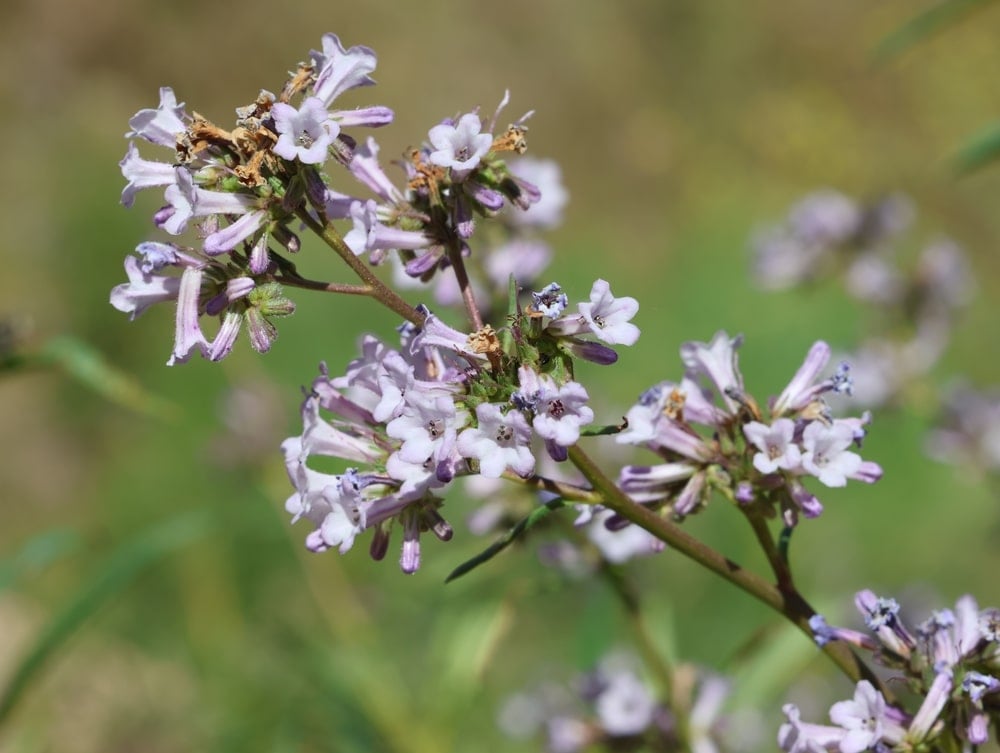
Yerba Santa, often referred to as the “holy herb,” is a revered aromatic shrub native to the southwestern United States and northern Mexico. Known scientifically as Eriodictyon californicum, this sacred herb has deep roots in Native American tribes’ traditional herbal medicine, particularly among the Chumash, Paiute, and Pomo peoples. Its common names include California yerba santa, mountain balm, bear’s weed, consumptive’s weed, gum plant, and holy weed, reflecting its wide-ranging medicinal properties and cultural significance.
Botanical Description and Habitat
Yerba Santa is an evergreen aromatic shrub that thrives in the chaparral and woodlands of California, Oregon, and northern Mexico. It typically grows between 2 to 8 feet tall, with woody lower branches and lance-shaped leaves that are glossy green on top and lighter with a net-like pattern underneath. The sticky, aromatic leaves emit an uplifting aroma, which has made the plant a staple in both spiritual practices and herbal preparations. From late spring to early summer, the plant produces tubular flowers that range in color from white to lavender.
Historical and Cultural Significance
The name “yerba santa,” meaning “holy herb” in Spanish, was given by Spanish missionaries who recognized the plant’s medicinal value through interactions with indigenous tribes. These native American tribes used yerba santa leaves extensively for respiratory ailments, wounds, and spiritual cleansing. The plant was also a key component in smudging rituals designed to purify spaces and promote emotional healing. Its use in the Spanish missions further cemented its place in traditional herbal medicine.
Medicinal Properties and Uses
Yerba santa is renowned for its potent medicinal properties, particularly in supporting respiratory health. The leaves have been traditionally boiled to make herbal teas or prepared as tinctures and poultices to treat respiratory conditions such as asthma, bronchitis, colds, and seasonal allergies. The herb’s anti-inflammatory and expectorant effects help clear mucus and reduce inflammation in the sinuses, throat, and lungs, making it a valuable remedy for respiratory ailments.
The plant contains a rich profile of bioactive compounds, including flavonoids like sterubin, eriodictyol, and homoeriodictyol, which contribute to its antioxidative and anti-inflammatory effects. Recent studies highlight the neuroprotective properties of eriodictyon californicum extract, suggesting potential benefits for age-associated phenotypic screening and even Alzheimer’s disease. Additionally, yerba santa has been investigated for its role as a natural food supplement to aid weight management and energy metabolism.
Herbal Preparations and Dosage
Yerba santa leaves are commonly consumed as herbal teas, tinctures, or smoked as part of herbal healing practices. The traditional preparation involves steeping dried leaves in hot water to extract the medicinal compounds. Tinctures made from fresh or dried leaves provide a concentrated form of the active ingredients, allowing for smaller doses with potent effects.
While there is no universally established appropriate dose, following relevant directions on product labels and consulting a healthcare provider is advised, especially during pregnancy or breastfeeding, as safety data is limited. Yerba santa is generally considered safe when used in moderate amounts, but natural products are not necessarily safe in all doses.
Yerba Santa in Spiritual Practices
Beyond its physical healing properties, burning yerba santa has long been used in smudging rituals to purify spaces and clear negative energies. This practice, deeply rooted in indigenous tribes’ traditions, continues in modern spiritual practices worldwide. The aromatic leaves’ uplifting aroma is believed to promote emotional balance, protection, and empowerment.
Synergistic Use with Other Herbs
Yerba santa is often combined with other medicinal herbs in herbal preparations to enhance therapeutic effects. Its compatibility with other herbs makes it a versatile component in holistic wellness routines aimed at respiratory health, immune support, and emotional healing.
Conservation and Ethical Considerations
As a native medicinal plant with cultural significance, sourcing California yerba santa responsibly is vital to preserving its availability for future generations. Sustainable harvesting and respect for indigenous knowledge ensure that this sacred herb remains a valuable resource in both traditional and modern herbal medicine.
By embracing yerba santa’s rich heritage and diverse medicinal uses, individuals can benefit from this potent neuroprotective compound and aromatic shrub. Whether incorporated into herbal teas, tinctures, or spiritual practices, yerba santa offers a holistic approach to health that honors its legacy as much more than just an herb. It is a true gift from the land, bridging ancient wisdom with contemporary herbal healing.
References
- Chevalier, A. (1996). The Encyclopedia of Medicinal Plants. DK Publishing.
- Duke, J. A. (1992). Handbook of Biologically Active Phytochemicals and Their Activities. CRC Press.
- Fischer, W., Currais, A., Liang, Z., Pinto, A., & Maher, P. (2019). Old age-associated phenotypic screening for Alzheimer’s disease drug candidates identifies sterubin as a potent neuroprotective compound from Yerba santa. Redox Biology, 21, 101089.
- Hofmann, J., Fayez, S., Scheiner, M., et al. (2020). Sterubin: enantioresolution and configurational stability, enantiomeric purity in nature, and neuroprotective activity in vitro and in vivo. Chemistry, 26(32), 7299-7308.
- Khan, I. A., & Abourashed, E. A. (2010). Leung’s Encyclopedia of Common Natural Ingredients Used in Food, Drugs, and Cosmetics. Wiley.
- Maher, P., Fischer, W., Liang, Z., et al. (2020). The value of herbarium collections to the discovery of novel treatments for Alzheimer’s disease, a case made with the genus Eriodictyon. Frontiers in Pharmacology, 11, 208.
- Mödinger, Y., Schön, C., Wilhelm, M., Pickel, C., & Grothe, T. (2021). A food supplement with antioxidative santa herba extract modulates energy metabolism and contributes to weight management. Journal of Medicinal Food, 24(11), 1235-1242.
- Sweet, M. (1976). Common Edible and Useful Plants of the West. Naturegraph Publishers.
Masterful Display
Each and everyone of our products are deeply considered, labored over, and improved upon time and time again. We invite you to experience the difference of our carefully crafted small batches of herbal support items. Whether it be our tea line, produced for a delightful experience, or our tincture blends and extracts, we have what you need.

